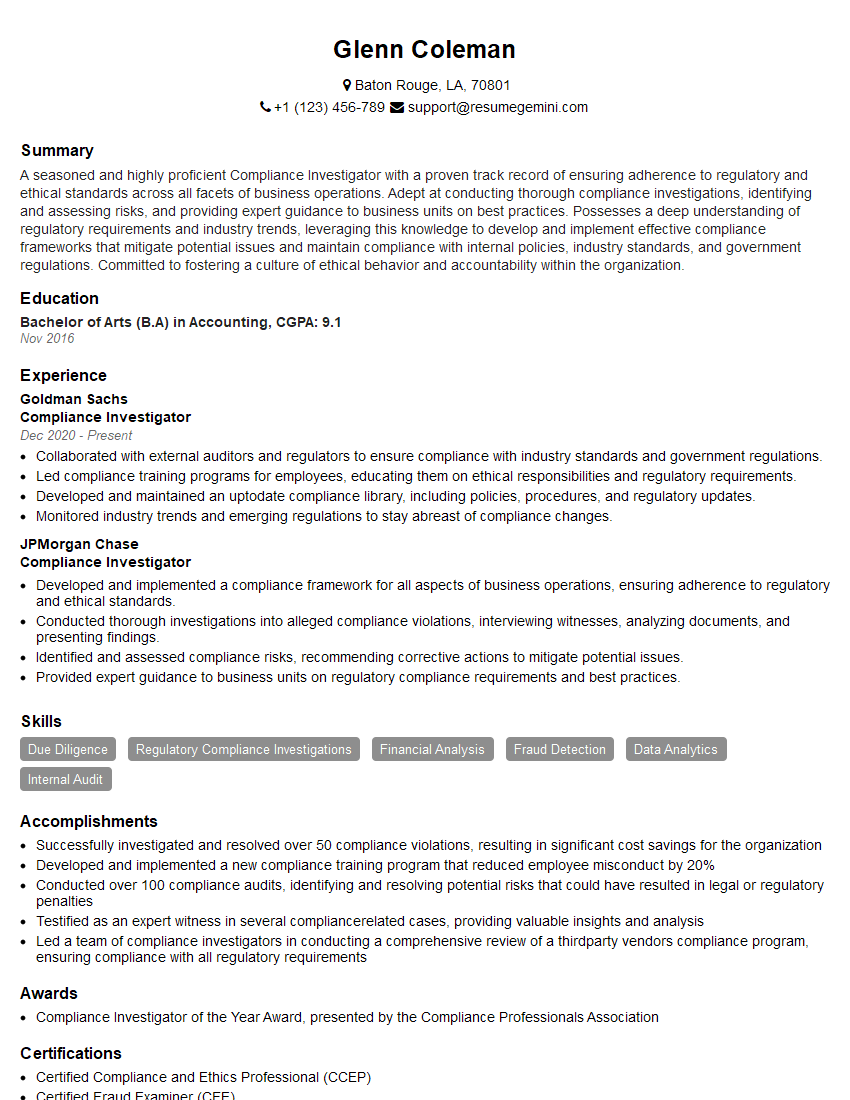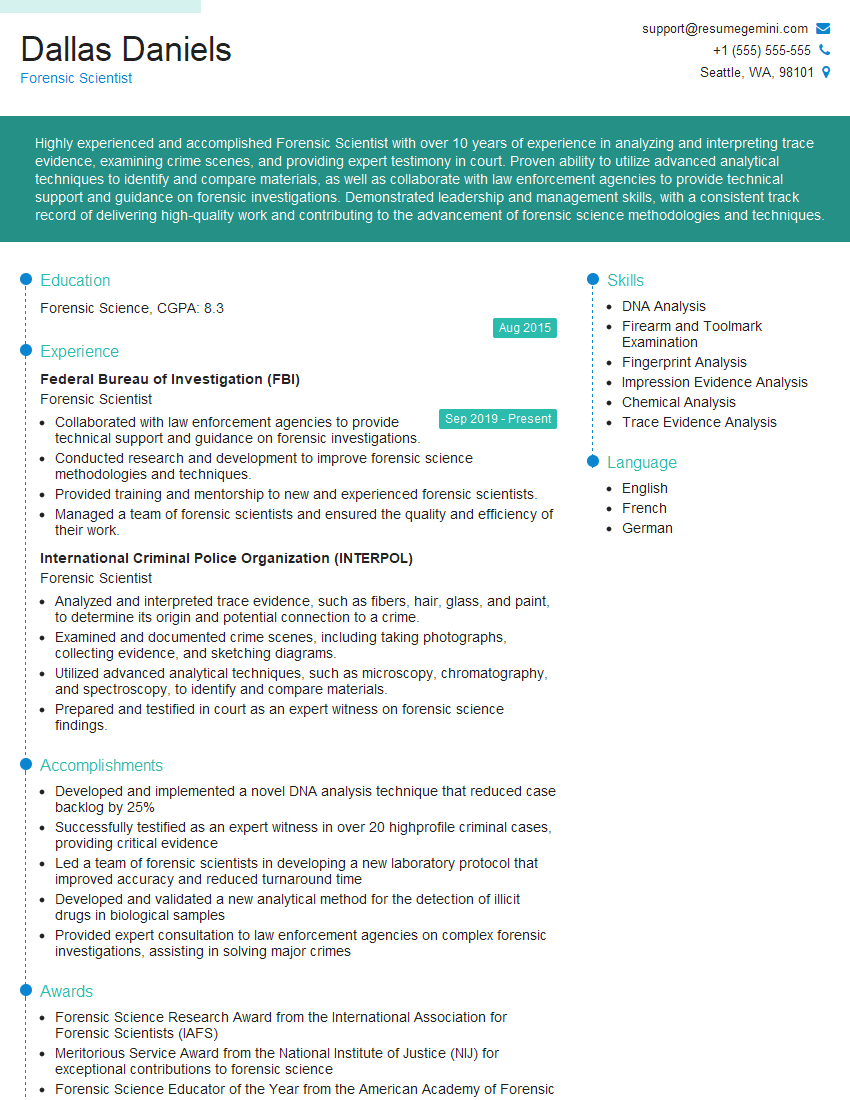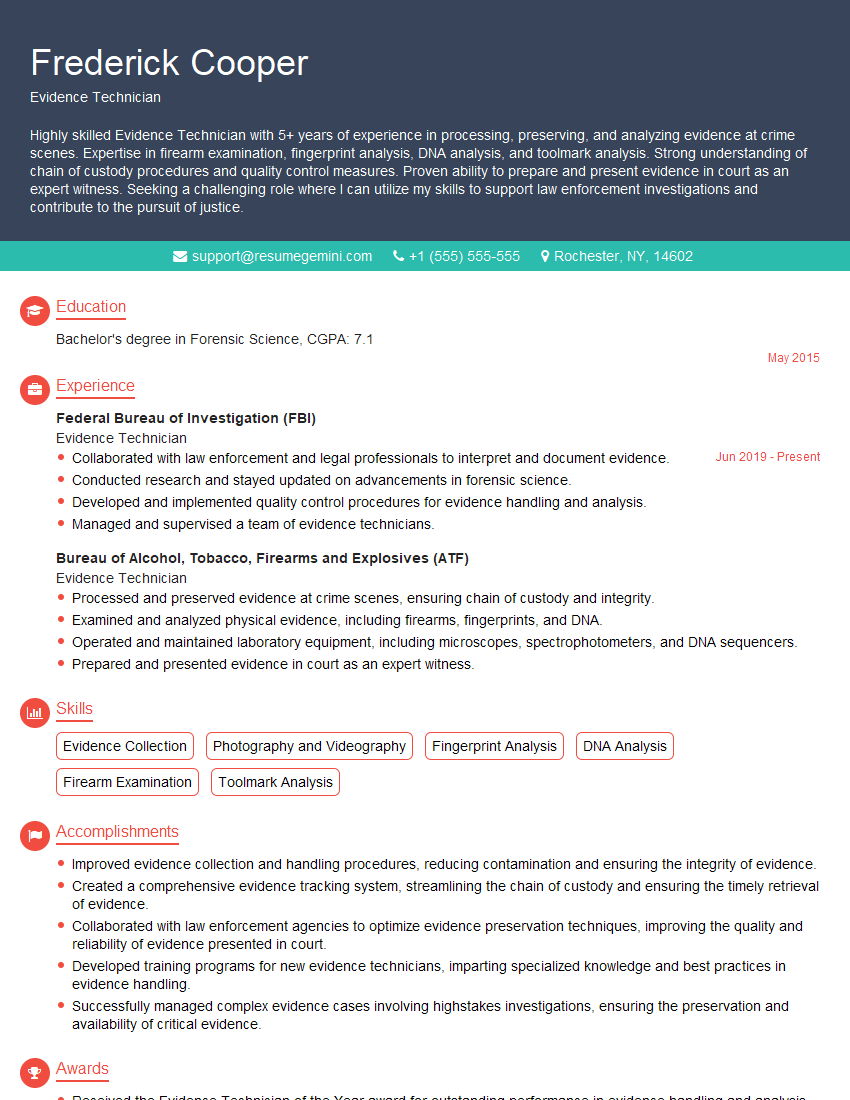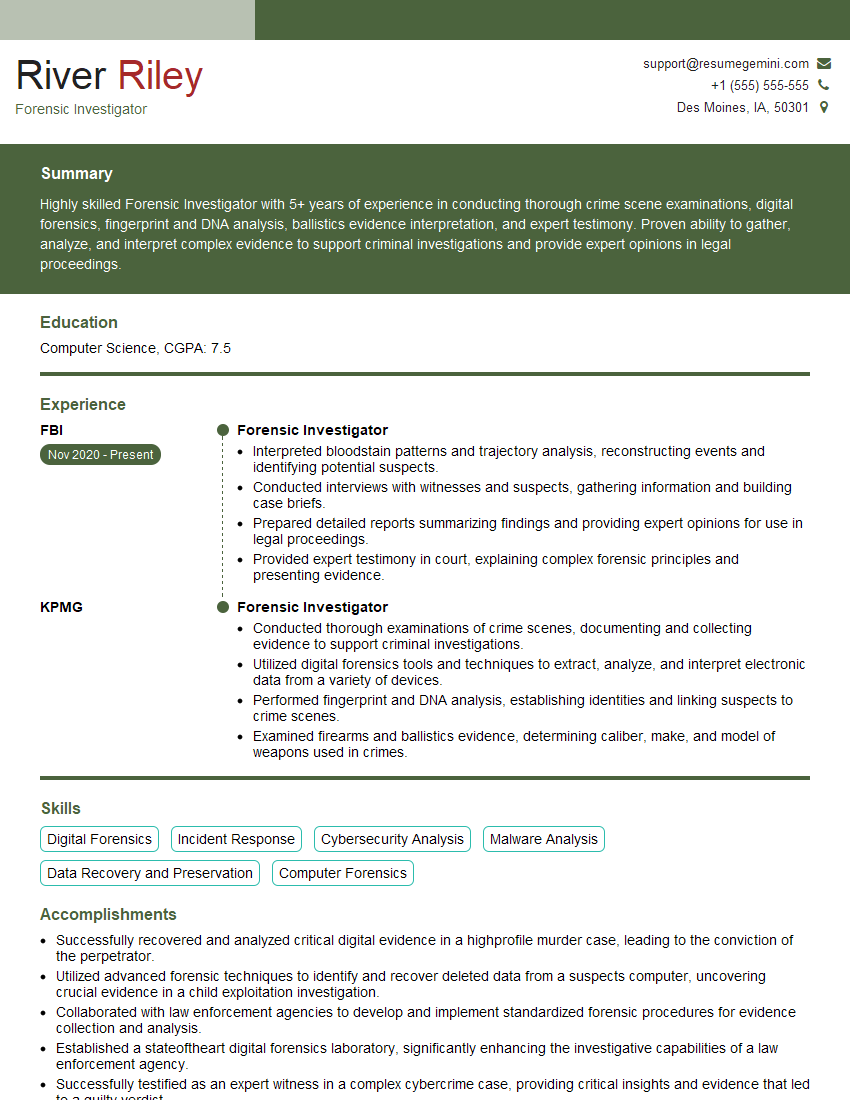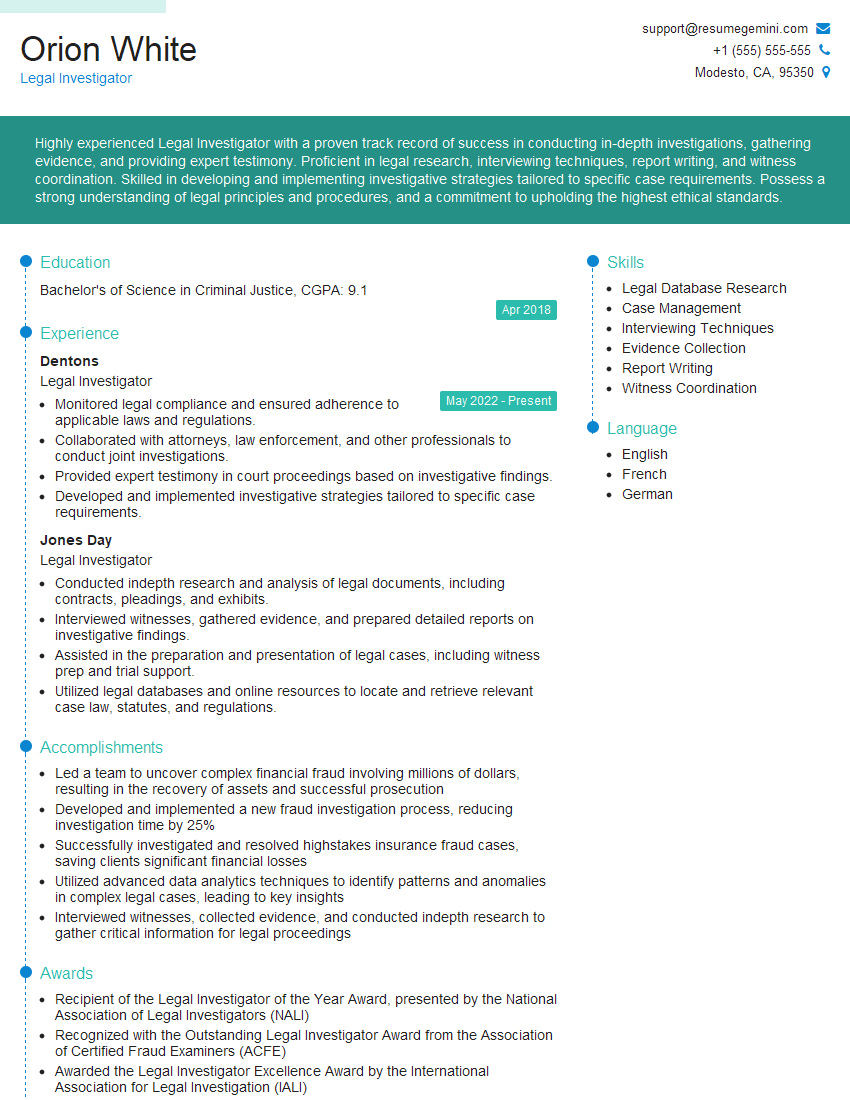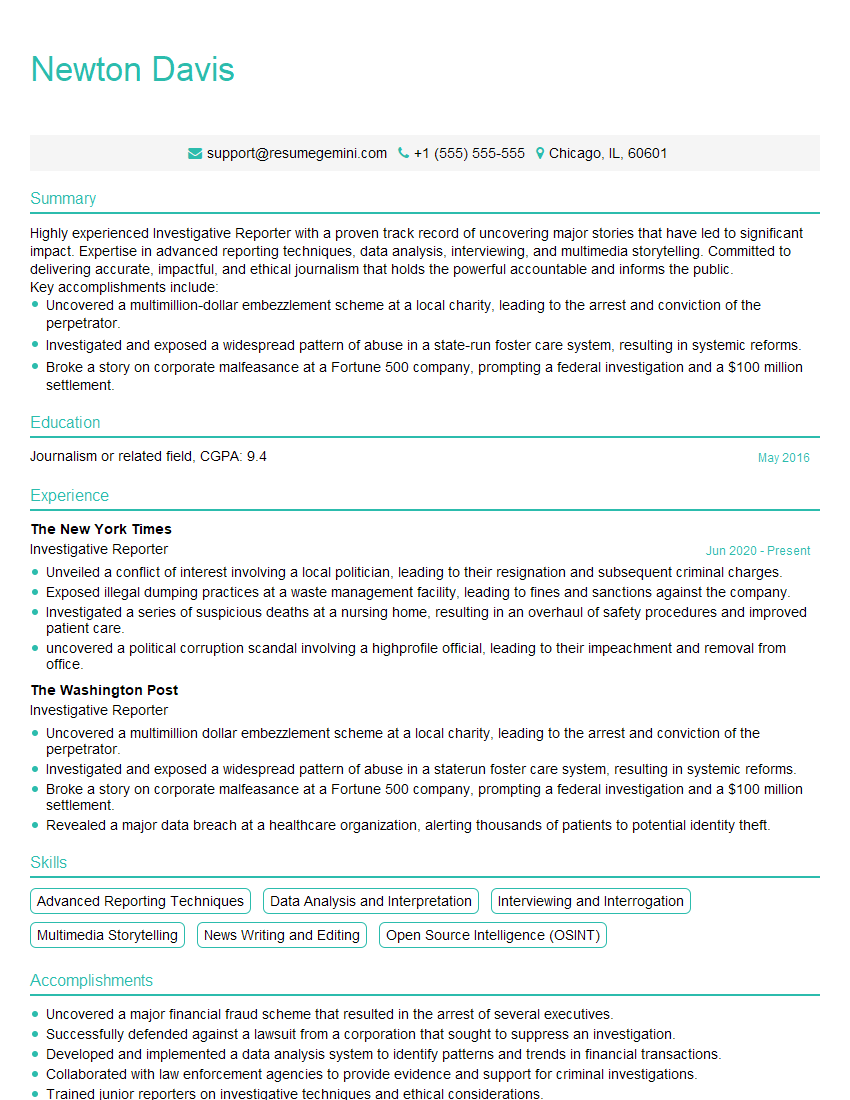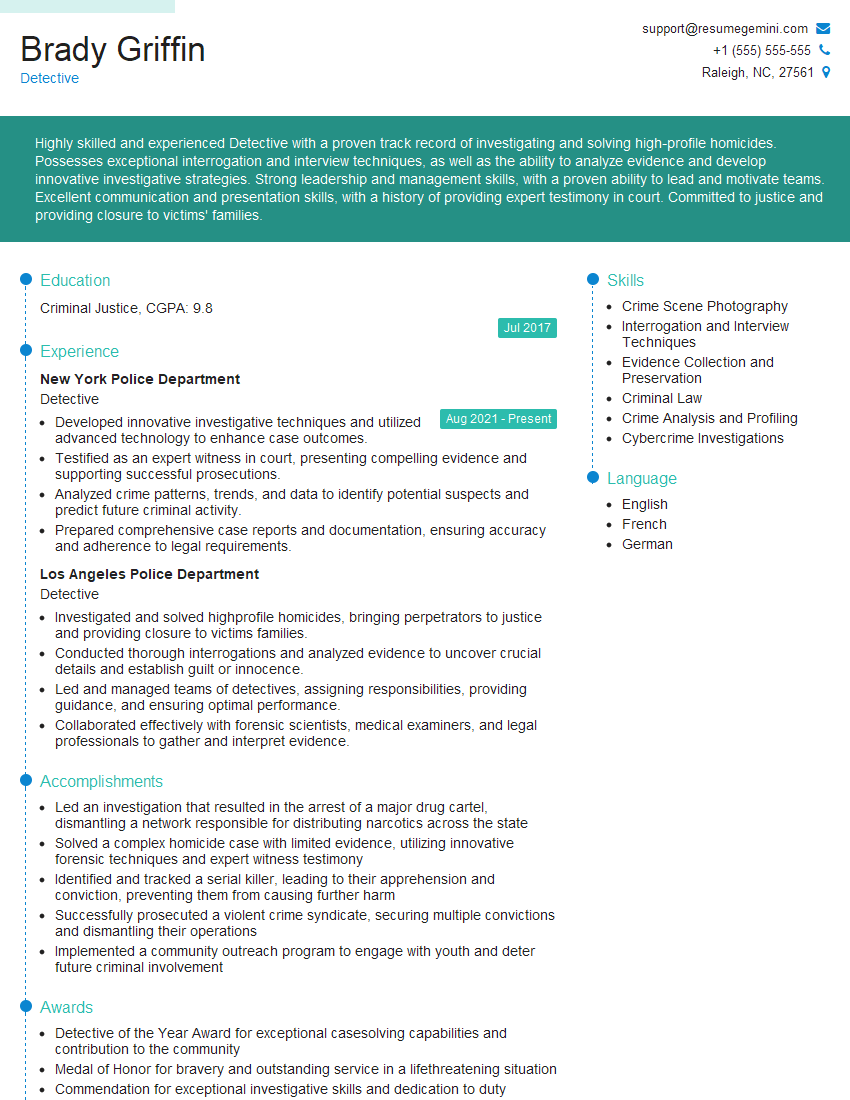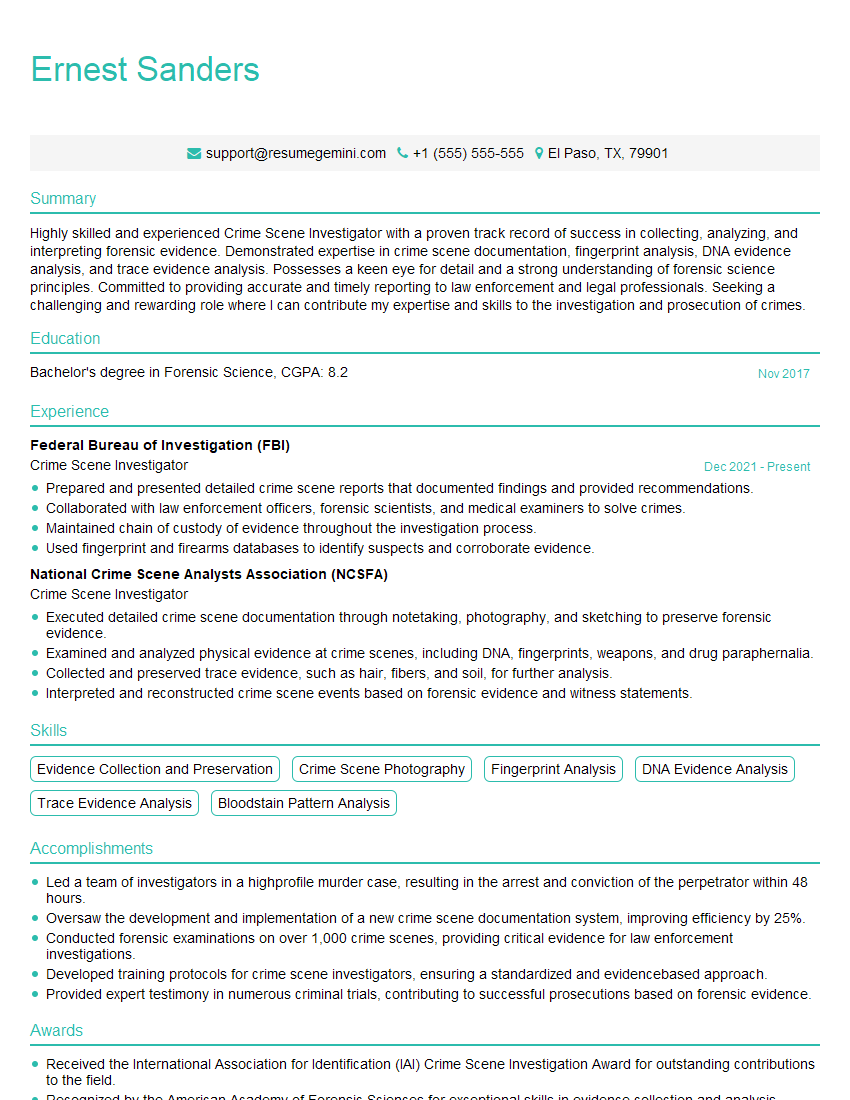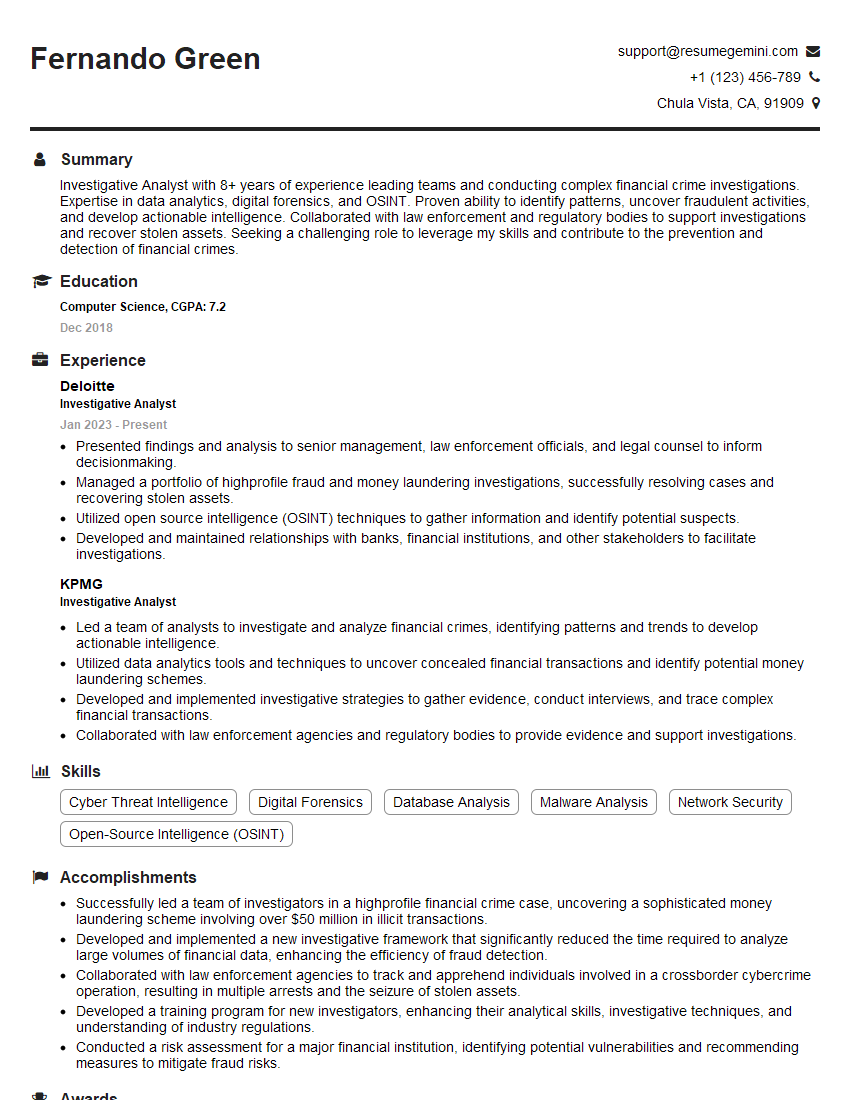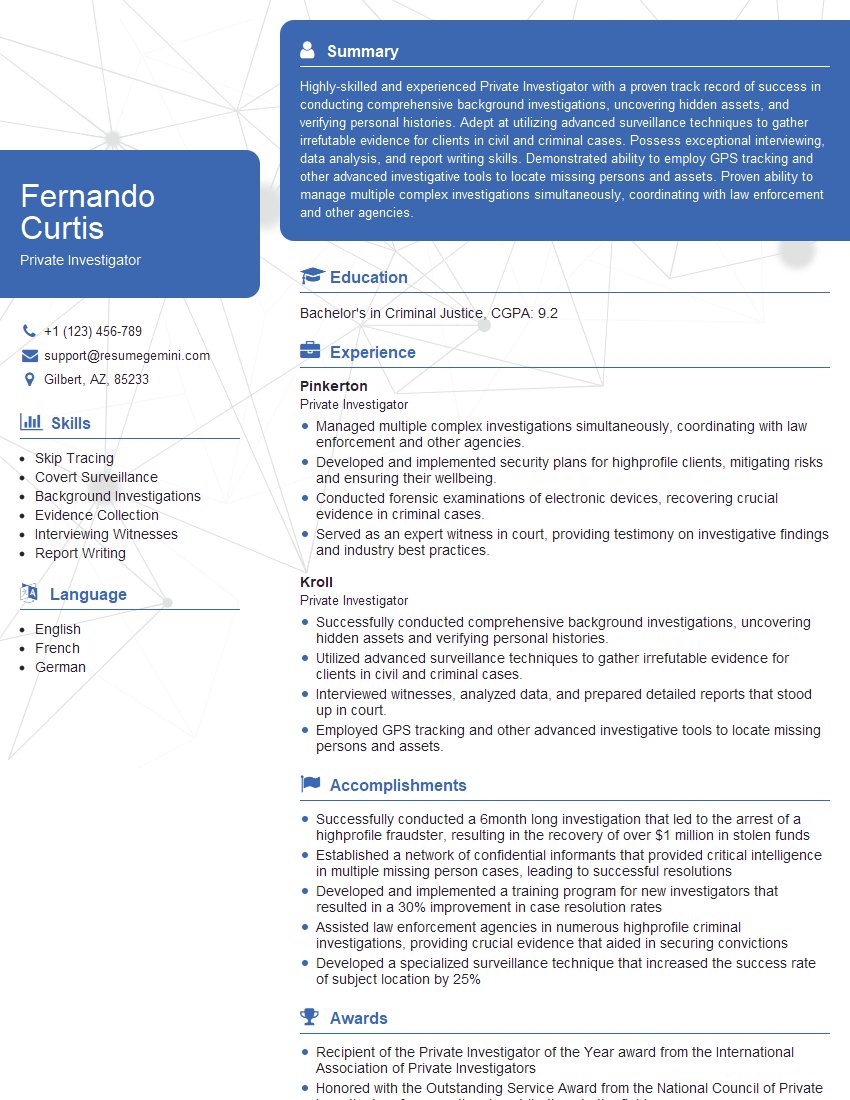Are you ready to stand out in your next interview? Understanding and preparing for Knowledge of Evidence Handling interview questions is a game-changer. In this blog, we’ve compiled key questions and expert advice to help you showcase your skills with confidence and precision. Let’s get started on your journey to acing the interview.
Questions Asked in Knowledge of Evidence Handling Interview
Q 1. Explain the importance of maintaining a chain of custody for evidence.
Maintaining a chain of custody for evidence is paramount to ensuring its admissibility in court. It’s essentially a meticulous record documenting everyone who has handled the evidence, from the moment it’s discovered to its presentation in court. Think of it like a relay race – each person who takes possession of the baton (evidence) must carefully document their receipt and transfer. Any break in this chain can severely compromise the evidence’s integrity and render it inadmissible, potentially jeopardizing an entire case.
This detailed record includes the date and time of each transfer, the names and contact information of individuals involved, and a description of any changes in the evidence’s condition. Without this careful tracking, the court can’t be certain that the evidence presented is the same evidence collected at the crime scene and hasn’t been tampered with. For example, if a crucial DNA sample was left unattended, allowing contamination, the chain of custody documentation would highlight this breach, potentially preventing its use as evidence.
Q 2. Describe the proper procedures for collecting and packaging different types of evidence (e.g., biological, digital, trace).
Collecting and packaging evidence requires meticulous attention to detail and varies greatly depending on the type of evidence. Each type demands specific handling procedures to prevent contamination, degradation, or damage.
- Biological Evidence (e.g., blood, saliva, hair): This requires the use of sterile equipment and packaging. The evidence should be air-dried before being placed in breathable paper bags, never plastic, to avoid mold growth. Each item is individually bagged and labeled, with chain of custody documentation attached. Imagine collecting a blood sample – you would use sterile swabs and gloves, place the swab in a paper bag, seal it, and immediately record the chain of custody information on the bag itself.
- Digital Evidence (e.g., computers, cell phones): Requires specialized forensic tools and techniques to ensure data integrity. Images of the hard drive are created before anything is touched; then, the original device is carefully packaged and transported to a secure forensic lab for analysis. The chain of custody documents the location of the device at all times and anyone who accessed it. Think of it like creating a forensic copy of a hard drive – any alteration on the original after forensic imaging would be immediately obvious and noted.
- Trace Evidence (e.g., fibers, hair, glass): Trace evidence is often collected using specialized tools like forceps or vacuum cleaners. Each item should be packaged in a separate, clearly labeled container, such as a bindle (small paper fold), to prevent cross-contamination. Imagine carefully collecting glass fragments from a crime scene – each fragment is placed in a separate bindle, which is then placed in a larger labeled evidence bag.
Q 3. What are the potential consequences of improper evidence handling?
Improper evidence handling can have severe consequences, leading to the dismissal of charges, wrongful convictions, and a loss of public trust in the justice system. Evidence that is contaminated, altered, or improperly handled can be deemed inadmissible in court, rendering the case weak or impossible to win. The case may be thrown out altogether. For instance, if a crucial piece of evidence was mishandled, it may be rejected by the judge, weakening the prosecution’s case to the point where the suspect might be released, potentially putting the community at risk. Conversely, inaccurate evidence can lead to wrongful convictions, where innocent individuals are incarcerated due to errors in evidence handling.
Q 4. How do you ensure the integrity and admissibility of evidence in court?
Ensuring the integrity and admissibility of evidence hinges on adhering strictly to established protocols throughout the entire process. This includes proper collection, packaging, storage, and transportation using tamper-evident seals and chain of custody documentation. Detailed photographic and video documentation of the crime scene, evidence collection, and packaging helps create an irrefutable record of the evidence’s journey. Further, meticulous lab analysis, conducted by certified professionals, ensures the integrity of any scientific evidence. Finally, careful presentation of this evidence in court, explaining each step of the chain of custody and analysis, is crucial to establishing its admissibility and weight.
Think of it as building a strong, airtight case. Each element – proper collection, documentation, analysis, and presentation – is a brick in the wall. Any weak spot can compromise the entire structure. By following these procedures, we create a robust, reliable foundation for a fair and just legal process.
Q 5. Explain the difference between direct and circumstantial evidence.
Direct evidence directly proves a fact in issue, without requiring any inferences. It’s essentially eyewitness testimony or a confession. For example, an eyewitness who saw the defendant commit the crime provides direct evidence. In contrast, circumstantial evidence requires the court to draw inferences or deductions to connect it to a fact in issue. For example, finding the defendant’s fingerprints at the crime scene is circumstantial evidence – it suggests involvement but doesn’t directly prove guilt. Multiple pieces of circumstantial evidence can build a compelling case, but direct evidence is generally considered stronger.
Q 6. What are some common challenges encountered in evidence handling, and how do you overcome them?
Several challenges exist in evidence handling. Contamination is a major concern, especially with biological and trace evidence. Maintaining the integrity of digital evidence, given its vulnerability to alteration or deletion, is another significant challenge. Budgetary limitations can impact access to specialized equipment and training, while personnel shortages can lead to overworked and potentially less careful evidence handling. Lastly, the sheer volume of evidence in complex cases can be overwhelming, requiring efficient management systems.
We overcome these challenges through rigorous training, use of proper equipment and protocols, and thorough documentation. Implementing robust quality control measures within forensic laboratories and utilizing digital evidence management systems can further mitigate risks. Cross-training personnel to handle different types of evidence and improving interagency collaboration can enhance efficiency and mitigate personnel constraints. Maintaining detailed records and leveraging technology for case management can also help mitigate challenges related to evidence volume.
Q 7. Describe your experience with various types of evidence documentation.
My experience encompasses a wide range of evidence documentation methods. I’m proficient in using digital photography and videography to document crime scenes and evidence collection. I’m also skilled in creating detailed written reports, including chain of custody documentation. I am familiar with various forensic software packages designed for analyzing and managing digital evidence, including the creation and validation of forensic images and hashing algorithms. Moreover, I have experience with specialized documentation methods for specific evidence types, such as the meticulous record-keeping required for trace evidence analysis. In all cases, accuracy and adherence to best practice guidelines are paramount to create complete, reliable, and legally defensible documentation.
Q 8. How do you handle contaminated or compromised evidence?
Handling contaminated or compromised evidence requires meticulous attention to detail and adherence to strict protocols to maintain its integrity and admissibility in court. The first step is immediate isolation of the potentially compromised evidence. This prevents further contamination and ensures a chain of custody is not broken.
Next, we document the contamination. This involves creating detailed notes and photographs detailing the nature and extent of the contamination. We might even collect samples of the contaminant itself. For example, if a blood sample is contaminated with another substance, we would meticulously note the location and appearance of the contamination and possibly analyze the contaminant separately.
Depending on the nature of the contamination, we might use specialized cleaning techniques, such as using sterile tools and solutions to carefully remove the contaminant without destroying the original evidence. If cleaning is not possible or deemed too risky, we would carefully package the evidence to prevent further damage and clearly label it as ‘compromised’. The chain of custody documentation must clearly reflect the compromise and all actions taken. This meticulous documentation is crucial to ensure the evidence is still considered admissible, even with its imperfections.
Q 9. What is your understanding of the Frye Standard and Daubert Standard regarding the admissibility of scientific evidence?
The Frye Standard and the Daubert Standard are two different legal tests used in U.S. courts to determine the admissibility of scientific evidence. The Frye Standard, established in the 1923 Frye v. United States case, dictates that scientific evidence is admissible only if it has gained ‘general acceptance’ within the relevant scientific community. It’s a relatively simpler test focused on widespread acceptance.
The Daubert Standard, arising from the 1993 Daubert v. Merrell Dow Pharmaceuticals case, is more complex and emphasizes the reliability and validity of the scientific methods used to generate the evidence. Under Daubert, judges act as ‘gatekeepers,’ evaluating the evidence based on several factors, including:
- Whether the scientific theory or technique can be and has been tested.
- Whether the theory or technique has been subjected to peer review and publication.
- The known or potential rate of error of the scientific technique.
- The existence and maintenance of standards controlling the technique’s operation.
- The general acceptance of the technique within the relevant scientific community (this echoes Frye, but is not the sole criterion).
In practice, the Daubert Standard is more rigorous and provides judges with more discretion in evaluating the admissibility of scientific evidence. The choice between Frye and Daubert depends on the jurisdiction.
Q 10. Explain the concept of ‘relevance’ in the context of evidence admissibility.
Relevance, in the context of evidence admissibility, means that the evidence must have a tendency to make a fact more or less probable than it would be without the evidence, and the fact must be of consequence in determining the action. Simply put, the evidence must matter to the case.
For example, if a murder case hinges on the time of death, a witness’s testimony placing the defendant near the scene at the approximate time of death is relevant. Conversely, the defendant’s favorite color would likely be considered irrelevant. Relevance is a threshold issue. Even if relevant, evidence can still be inadmissible due to other reasons, such as hearsay rules or concerns about unfair prejudice.
The concept of relevance involves a two-pronged test: It must be probative (tending to prove something) and material (related to a matter in dispute). Judges have the discretion to exclude relevant evidence if its probative value is substantially outweighed by a danger of, for example, misleading the jury, undue delay, or needless presentation of cumulative evidence.
Q 11. How do you prioritize evidence collection at a crime scene?
Prioritizing evidence collection at a crime scene is crucial to ensuring that the most important and potentially fragile evidence is secured first. The process often follows a systematic approach, prioritizing the following:
- Preservation of life: Ensuring the safety of any victims or witnesses is paramount.
- Securing the scene: Establishing a perimeter to prevent unauthorized access and contamination.
- Transient evidence: This is evidence that can be easily lost or altered, such as footprints, tire tracks, bloodstains, or other marks which may fade or be destroyed. These should be documented and collected first.
- Fragile evidence: Items that are easily damaged, such as glass fragments or fibers, are prioritized next.
- Trace evidence: Small items such as hairs, fibers, and paint chips are carefully collected after the more obvious items.
- Other evidence: Weapons, documents, and other more stable items are collected afterward.
A detailed and systematic approach minimizes the risk of overlooking critical evidence and ensures the integrity of what is collected. A good understanding of the crime and the potential evidence to be expected aids this prioritization greatly.
Q 12. What are some ethical considerations related to evidence handling?
Ethical considerations in evidence handling are paramount, impacting the integrity of investigations and the fairness of the justice system. Key ethical considerations include:
- Maintaining the chain of custody: Every person who handles evidence must be documented. This ensures accountability and prevents tampering accusations.
- Avoiding contamination or destruction: Proper handling techniques are essential to protect the integrity and evidentiary value of collected materials.
- Objectivity and impartiality: Investigators should strive to collect and handle evidence in an objective manner, without bias or prejudice.
- Confidentiality: Sensitive or personal information contained within evidence must be protected and handled confidentially.
- Truthfulness and honesty: Complete and accurate documentation of all evidence handling procedures is crucial. Misrepresenting or withholding information is unethical and illegal.
Ethical breaches can lead to the dismissal of evidence, compromised cases, and loss of public trust in the legal system. A strong ethical foundation is essential for professional integrity.
Q 13. Describe your experience with using specialized equipment for evidence collection (e.g., UV light, alternative light sources).
I have extensive experience using specialized equipment for evidence collection. Alternative light sources (ALS), such as UV and blue light, are invaluable for locating trace evidence like bodily fluids, fibers, and fingerprints that are not readily visible to the naked eye. For example, using ALS to detect latent fingerprints on a dark surface can significantly aid an investigation.
UV light can reveal substances that fluoresce, while blue light can enhance the contrast of certain stains, improving detection. We also utilize forensic photography equipment to accurately document the location and appearance of evidence detected with ALS. Proper documentation and calibration of equipment are crucial for obtaining accurate and reliable results in court, and I am meticulous about that process.
Other equipment I use frequently includes various types of microscopes for analyzing trace evidence and tools for safely packaging and preserving collected samples to maintain their integrity. Staying abreast of advancements in forensic technology is also critical to my work.
Q 14. How do you handle sensitive or confidential evidence?
Handling sensitive or confidential evidence demands rigorous adherence to privacy laws and ethical standards. The first step is secure storage—often in locked, controlled-access facilities with limited personnel access. Access logs are meticulously maintained, tracking who accessed the evidence and when.
Depending on the type of evidence, additional security measures may be implemented, such as encryption for digital evidence or specialized packaging for biological samples. This prevents unauthorized access, potential breaches of privacy, and the compromise of the investigation. Furthermore, access to this evidence is strictly limited to authorized personnel on a need-to-know basis. When transporting sensitive evidence, secure transportation methods are used to prevent theft or damage. All aspects of handling are thoroughly documented to ensure complete transparency and accountability.
Q 15. Explain your understanding of evidence preservation techniques.
Evidence preservation is paramount in ensuring the integrity and admissibility of evidence in any legal or investigative context. It’s all about maintaining the evidence in its original state, preventing alteration, damage, or loss. This involves a multi-faceted approach encompassing various techniques, tailored to the specific type of evidence.
- Physical Evidence: This often involves proper packaging (e.g., sealed bags for clothing, tamper-evident containers for biological samples), labeling with unique identifiers and case details, and storing in a secure, climate-controlled environment to prevent degradation.
- Digital Evidence: Digital preservation involves creating forensic images of hard drives, memory cards, and other storage devices. This creates a bit-by-bit copy, leaving the original untouched. Hash values are generated to verify the integrity of the copy and ensure no data alteration occurred. The original evidence is then stored securely, often in a write-protected state.
- Chain of Custody Documentation: This is crucial for all evidence types. Meticulous records are maintained to track who handled the evidence, when, and under what circumstances. This ensures the evidence’s provenance can be clearly established.
For example, in a cybercrime investigation, a forensic image of a suspect’s computer would be created and verified. The original hard drive would be stored in a secure evidence locker, while the forensic image is used for analysis. This prevents any potential alteration of the original evidence.
Career Expert Tips:
- Ace those interviews! Prepare effectively by reviewing the Top 50 Most Common Interview Questions on ResumeGemini.
- Navigate your job search with confidence! Explore a wide range of Career Tips on ResumeGemini. Learn about common challenges and recommendations to overcome them.
- Craft the perfect resume! Master the Art of Resume Writing with ResumeGemini’s guide. Showcase your unique qualifications and achievements effectively.
- Don’t miss out on holiday savings! Build your dream resume with ResumeGemini’s ATS optimized templates.
Q 16. How do you ensure the security of evidence during storage and transportation?
Security during storage and transportation is critical to maintaining evidence integrity. Compromised evidence is inadmissible in court, undermining the entire investigation. My approach focuses on several key elements:
- Secure Storage: Evidence is stored in locked, climate-controlled facilities with restricted access. This might involve specialized evidence lockers, vaults, or secure data centers, depending on the nature of the evidence.
- Chain of Custody: Strict adherence to chain of custody procedures is maintained throughout storage and transportation. Each transfer of custody is documented, including dates, times, personnel involved, and reasons for transfer.
- Transportation: Secure transportation involves using tamper-evident containers and vehicles. In cases involving sensitive digital evidence, encrypted storage devices are used, and transportation is planned to minimize transit time and ensure secure handling.
- Inventory and Tracking: Regular inventory checks and electronic tracking systems are employed to maintain an accurate record of the evidence’s location and status.
- Access Control: Access to evidence storage areas and the evidence itself is strictly controlled and limited to authorized personnel only.
Imagine transporting a seized computer. It would be placed in a tamper-evident bag, sealed, and transported in a locked vehicle. A detailed chain of custody record would document the entire process, noting each step and person involved.
Q 17. Describe your experience working with different types of forensic software or databases.
Throughout my career, I’ve worked extensively with a range of forensic software and databases. My experience spans both commercial and open-source tools, allowing me to choose the best tool for the specific task and evidence type.
- Forensic Imaging Software: I am proficient in using tools like FTK Imager, EnCase, and dd to create forensic images of digital media. These tools allow for the creation of bit-stream copies, ensuring data integrity.
- Data Analysis Software: I’ve used tools like Autopsy, The Sleuth Kit, and Magnet AXIOM to analyze forensic images and extract relevant evidence such as deleted files, browsing history, and network artifacts.
- Database Systems: Experience with case management databases and evidence tracking systems ensures efficient organization and retrieval of evidence. These systems help manage the chain of custody, providing an audit trail for every piece of evidence.
For instance, in a case involving a suspected data breach, I would use FTK Imager to create a forensic image of a compromised server, followed by Autopsy to analyze the image for malware, compromised accounts, and deleted files to determine the extent and nature of the attack. The entire process is documented within the case management database.
Q 18. How do you manage a large volume of evidence effectively?
Managing a large volume of evidence requires a systematic and organized approach. Inefficient management can lead to delays, confusion, and potential loss or contamination of evidence. Effective strategies include:
- Centralized Database: Utilizing a centralized database to track all evidence, including its location, status, and chain of custody. This allows for easy searching, retrieval, and reporting.
- Metadata Tagging: Assigning meaningful metadata tags to evidence items to facilitate efficient searching and filtering. This improves searchability and allows for quick retrieval of specific pieces of evidence.
- Evidence Classification: Categorizing evidence into logical groups to simplify management. This could be based on evidence type, case number, or other relevant criteria.
- Automation: Utilizing automated tools and workflows to streamline evidence processing and management tasks. This includes automating report generation, chain of custody updates, and evidence tracking.
- Regular Audits: Performing regular audits to ensure the accuracy and completeness of the evidence database and to identify any gaps or inconsistencies.
Think of a large-scale investigation with thousands of digital files. A well-structured database system allows for efficient searching, filtering, and retrieval of specific files based on metadata like file type, date, or keywords. This prevents the tedious and time-consuming task of manually searching through vast amounts of data.
Q 19. What steps do you take to prevent evidence tampering or contamination?
Preventing evidence tampering or contamination is crucial. A single breach can compromise the entire case. My approach employs several safeguards:
- Proper Handling Procedures: Establishing and strictly adhering to standardized handling procedures for each type of evidence to minimize contamination risk. This includes using gloves, masks, and other protective equipment where appropriate.
- Chain of Custody: Meticulous chain of custody documentation is used to track the movement and handling of all evidence. This provides an audit trail and helps to detect any potential tampering.
- Secure Storage: Storing evidence in secure, tamper-evident containers and facilities to prevent unauthorized access or modification.
- Hashing and Verification: For digital evidence, using cryptographic hash functions to verify data integrity. Hash values are calculated at each stage of the process and compared to ensure no data alteration occurred. This creates a digital signature, confirming the authenticity and integrity of the data.
- Regular Inspections: Regularly inspecting evidence for any signs of tampering or degradation. This includes checking seals, labels, and hash values.
For instance, in a homicide investigation, careful handling of biological samples is critical to avoid contamination. Gloves, masks, and sterile instruments are used, and the chain of custody is meticulously documented. Any deviation is immediately flagged and investigated.
Q 20. Describe your experience with evidence analysis techniques.
Evidence analysis techniques vary widely depending on the type of evidence. My expertise encompasses a wide range of methods, including:
- Digital Forensics: Analyzing digital devices for evidence of cybercrime, including malware, deleted files, browsing history, and network activity. This involves using forensic software and techniques to recover deleted data and reconstruct events.
- Network Forensics: Examining network traffic and logs to identify intrusions, data breaches, and other cyber threats. This involves analyzing network packets, logs, and other network data to pinpoint the source and nature of an attack.
- Mobile Forensics: Extracting and analyzing data from mobile devices, such as smartphones and tablets, to uncover evidence related to various crimes. This includes recovering deleted messages, call logs, and location data.
- Multimedia Forensics: Analyzing images, videos, and audio recordings for authenticity and manipulation. Techniques include analyzing metadata, detecting image editing, and using specialized software to uncover inconsistencies or alterations.
In a case involving an alleged forged document, I might use multimedia forensics techniques to analyze the document’s metadata, image characteristics, and compare it to known samples to determine if it has been altered or created fraudulently.
Q 21. How do you document the chain of custody for digital evidence?
Documenting the chain of custody for digital evidence is critical to its admissibility in court. It must be demonstrably free of tampering and alteration. I use a rigorous approach involving:
- Forensic Imaging: Creating a forensic image of the digital media using validated forensic software. This ensures that the original evidence is preserved and unaltered. The hash value of the image is immediately calculated and recorded.
- Hash Value Verification: Regularly verifying the hash value of the forensic image throughout the analysis process to ensure its integrity. Any discrepancy flags potential tampering.
- Detailed Logs: Maintaining detailed logs of all actions performed on the forensic image. This includes the date, time, user, and the specific actions taken.
- Evidence Tracking System: Using a dedicated evidence tracking system to record the chain of custody, including every person who accessed the evidence, the purpose of access, and the date and time of each action.
- Secure Storage: Storing the forensic image and original evidence in secure locations with restricted access. This minimizes risks of unauthorized access and tampering.
For example, if I analyze a forensic image of a hard drive, each step – from imaging to analysis – is logged, including the creation of hash values at each stage. These logs, along with the evidence tracking database, provide an undeniable chain of custody, proving the integrity of the evidence.
Q 22. How do you handle evidence disputes or discrepancies?
Evidence disputes are handled meticulously, prioritizing accuracy and objectivity. My approach involves a systematic review of all conflicting evidence, carefully examining each piece for potential biases, inconsistencies, or errors. This includes cross-referencing with other evidence, verifying the chain of custody, and analyzing the methodologies used to collect and preserve the evidence.
For instance, if two witness statements contradict each other regarding the time of an event, I would analyze their credibility by examining potential motivations for discrepancies, comparing their accounts to other corroborating evidence (such as security footage or physical evidence), and assessing their reliability through factors like clarity, consistency, and potential memory biases. A detailed report outlining the discrepancies, the analysis conducted, and the conclusions drawn would be prepared, potentially including recommendations for further investigation to resolve the conflict.
Ultimately, the goal is to present a clear and unbiased analysis of the conflicting evidence to support informed decision-making, whether that involves further investigation, or accepting one piece of evidence over another based on compelling reasons outlined in the report.
Q 23. What is your understanding of legal and regulatory requirements related to evidence handling?
My understanding of legal and regulatory requirements related to evidence handling is comprehensive and encompasses various jurisdictions and legal frameworks. This includes familiarity with rules of evidence, data protection laws (like GDPR or CCPA), and regulations specific to the type of evidence being handled (e.g., medical records, financial documents). I am acutely aware of the consequences of violating these regulations, ranging from legal sanctions to the inadmissibility of evidence in court.
For example, understanding chain of custody protocols is crucial – meticulously documenting the handling of evidence from collection to presentation to maintain its integrity and admissibility. Failure to adhere to these rules can lead to evidence being deemed unreliable and inadmissible. Similarly, understanding and abiding by data protection laws is paramount, especially when handling digital evidence or personal data. I understand the specific requirements of informed consent and data minimization, ensuring that all handling of such evidence is ethical and legal.
Q 24. Describe your familiarity with different legal standards governing evidence (e.g., hearsay, best evidence rule).
I am well-versed in legal standards governing evidence, including the intricacies of hearsay and the best evidence rule. Hearsay, broadly defined as an out-of-court statement offered to prove the truth of the matter asserted, is generally inadmissible unless it falls under a recognized exception. These exceptions, such as excited utterances or statements made for medical diagnosis, require careful consideration.
The best evidence rule dictates that the original document or recording should be produced unless its absence is satisfactorily explained. This rule aims to prevent inaccuracies or alterations that might occur with copies. Understanding these rules is crucial in determining the admissibility and weight of various pieces of evidence in legal proceedings. For example, a copy of a contract might be admissible if the original is lost and this loss is convincingly demonstrated, but its admissibility would still be considered weaker than the original.
Q 25. How do you collaborate effectively with other professionals involved in evidence handling?
Effective collaboration is paramount in evidence handling. I foster open communication and information sharing with all relevant professionals – investigators, lawyers, forensic specialists, and other experts. This includes regular meetings, clear documentation, and the use of collaborative platforms to ensure everyone is informed and working from the same information.
For instance, I would establish clear communication protocols at the outset of a case, defining roles and responsibilities, and establishing regular reporting mechanisms. Using a shared case management system allows for real-time updates and ensures everyone has access to the latest information, minimizing potential for miscommunication and ensuring that evidence is handled consistently and appropriately throughout the process.
Q 26. How do you stay updated on changes and advancements in evidence handling techniques?
Staying updated is crucial in this dynamic field. I achieve this through continuous professional development, attending conferences and workshops, participating in professional organizations (like the Association of Certified Fraud Examiners or similar organizations depending on the specialization), and regularly reading relevant journals and publications.
Furthermore, I actively seek out training on emerging technologies and techniques in evidence handling, such as advancements in digital forensics or DNA analysis. Keeping up-to-date ensures I am equipped to handle complex and evolving challenges in evidence gathering and analysis, using best practices in the field.
Q 27. Explain your experience with presenting evidence in a court of law or other formal setting.
I have extensive experience presenting evidence in various formal settings, including courts of law and regulatory hearings. My approach focuses on clear, concise, and objective presentation, ensuring the evidence is presented in a manner that is easily understandable and compelling.
This includes preparing detailed reports, creating clear visual aids (charts, graphs, timelines), and rehearsing my testimony to ensure confidence and clarity in delivery. I am prepared to address challenging questions from opposing counsel, always maintaining professionalism and objectivity, focusing on factual information and avoiding speculation. My goal is to ensure the evidence is understood and its significance is appreciated by the audience.
Q 28. How do you deal with incomplete or missing pieces of evidence?
Dealing with incomplete or missing evidence requires a careful and systematic approach. First, I thoroughly document the missing pieces, outlining what is missing and why. Then, I explore all possible avenues to locate the missing information. This could involve reviewing previous records, interviewing witnesses, or engaging additional resources.
If the missing information cannot be located, I assess the impact of the missing evidence on the overall findings. The analysis may be adjusted accordingly and the limitations of the investigation resulting from the incomplete data are clearly documented in the final report. Transparency and honesty about the limitations imposed by incomplete data are critical to maintaining the integrity of the investigation. For example, a gap in security footage might be acknowledged, and the limitations of the analysis due to this gap clearly stated.
Key Topics to Learn for Knowledge of Evidence Handling Interview
- Chain of Custody: Understanding the principles of maintaining unbroken chain of custody, documentation procedures, and potential pitfalls.
- Evidence Collection Techniques: Proper methods for collecting various types of evidence (digital, physical, biological), ensuring preservation and minimizing contamination.
- Legal and Ethical Considerations: Familiarity with relevant laws and regulations, ethical responsibilities in evidence handling, and potential legal challenges.
- Evidence Preservation and Storage: Best practices for storing and preserving evidence to maintain integrity and admissibility in court.
- Forensic Analysis Techniques (relevant to role): Depending on the specific job, this could include understanding basic principles of digital forensics, DNA analysis, or other relevant forensic techniques.
- Documentation and Reporting: Accurate and thorough documentation of all evidence handling procedures, including detailed reports and supporting documentation.
- Problem-Solving in Evidence Handling: Analyzing scenarios involving compromised evidence, potential contamination, or other challenges and proposing solutions.
- Data Integrity and Security: Maintaining the integrity and security of evidence, especially in digital contexts, through appropriate measures and protocols.
Next Steps
Mastering knowledge of evidence handling is crucial for career advancement in many fields, opening doors to specialized roles and increased responsibility. A strong understanding of these principles demonstrates professionalism, attention to detail, and a commitment to upholding the integrity of investigations. To maximize your job prospects, creating an ATS-friendly resume is vital. ResumeGemini is a trusted resource to help you build a compelling and effective resume that highlights your skills and experience. We offer examples of resumes tailored to Knowledge of Evidence Handling to help you get started. Invest time in crafting a professional resume—it’s your first impression on potential employers.
Explore more articles
Users Rating of Our Blogs
Share Your Experience
We value your feedback! Please rate our content and share your thoughts (optional).
What Readers Say About Our Blog
Interesting Article, I liked the depth of knowledge you’ve shared.
Helpful, thanks for sharing.
Hi, I represent a social media marketing agency and liked your blog
Hi, I represent an SEO company that specialises in getting you AI citations and higher rankings on Google. I’d like to offer you a 100% free SEO audit for your website. Would you be interested?
